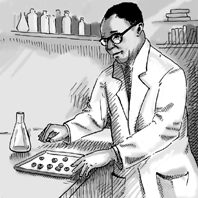Who Was Percy Julian?Dr. Percy Lavon Julian was a trailblazing chemist whose discoveries improved and saved countless lives. The grandson of slaves, Julian grew up at a time when African Americans faced extraordinary obstacles. Yet Julian refused to let racism prevent him from becoming one of the most influential scientists of the 20th century, as well as a leader in business and civil rights. Julian was born in Montgomery, Alabama, on April 11, 1899. He attended a segregated elementary school. And, because Montgomery had no public high school for African Americans, he was forced to attend a teacher training school. In 1916, Julian entered DePauw University, a largely white liberal arts school in Indiana. Despite the many struggles Julian faced, he not only earned a bachelor's degree in chemistry, he graduated Phi Beta Kappa and first in his class. Julian was the first African American to earn a master's degree in chemistry from Harvard University. Julian eventually became head of the chemistry department at Howard University, a leading African American institution. Determined to continue his education, Julian enrolled in the University of Vienna, where he earned a Ph.D. in chemistry—the fourth African American to achieve this distinction. It was in Vienna that he began his lifelong inquiry into the chemistry of plants. Returning to DePauw University, Julian became an expert in synthesis, the process of turning one substance into another through planned chemical reactions. In 1935, Julian and Josef Pikl synthesized physostigmine—still used to treat glaucoma—found in Calabar beans. The American Chemical Society later recognized their work as a National Chemical Landmark—one of the top 25 accomplishments in American chemical history. Despite this achievement, DePauw refused to appoint Julian to a permanent faculty position. Discrimination led Julian from academia to business. For over 18 years, his highly successful research for the Glidden Company uncovered new uses for chemicals from soybeans. Julian's work was not only enormously profitable, but it helped relieve human suffering across the globe. He extracted a soy protein used in fire-fighting foam, which saved thousands of lives during World War II. His process for isolating steroids from soybean oil led to the manufacture of synthetic hormones. He also played a key role in making synthetic cortisone affordable to millions of arthritis sufferers. In 1953, Julian established Julian Laboratories to produce synthetic steroids. He became a millionaire when he sold it in 1961. By the 1970s, Julian was widely recognized as an innovator who made medicines more affordable. For his contributions to humanity and civil rights, Julian received 18 honorary degrees and more than a dozen civic and scientific awards; he was the second African American elected to the National Academy of Sciences and the first chemist.
Percy Julian died of liver cancer in 1975, at the age of 76.
|

Percy Julian's Life 1899—Born in Montgomery, Alabama on April 11. 1899—Born in Montgomery, Alabama on April 11. 1920—Graduates first in his class from DePauw University with a bachelor's degree in chemistry. 1923—Earns master's degree in chemistry from Harvard University. 1928—Heads chemistry department at Howard University. 1931—Awarded Ph.D. from the University of Vienna, where he begins his work with plant compounds. 1932—Returns to teach at DePauw University. 1935—Succeeds in producing synthetic physostigmine, which leads to a glaucoma drug. Marries Anna Johnson, the first African American woman to earn a Ph.D. in sociology in the U.S. 1936—Begins working at the Glidden Company. 1939 Succeeds in producing progesterone on an industrial scale. 1940—Son Percy Jr. is born. 1942—Extracts a soybean protein that leads to the development of a fire-retardant foam that saves thousands of soldiers' lives in World War II. 1944—Daughter Faith is born. 1947—Receives the Spingarn Medal from the National Association for the Advancement of Colored People. 1949—Synthesizes Compound S, a major ingredient in low-cost cortisone. 1950—Named Chicagoan of the Year. 1951—Moves to Oak Park, Illinois, where his family's home is firebombed. 1953—Founds Julian Laboratories. 1961—Sells the company for $2.3 million. 1960s and 1970s—Works with civil rights groups to fight discrimination. 1973—Elected to the National Academy of Sciences. 1975—Dies on April 19. 1993—U.S. Postal Service issues stamp in his honor.
Tune in |
|
Forgotten Genius Home | Send Feedback | Image Credits | Support NOVA |
© | Created January 2007 |
